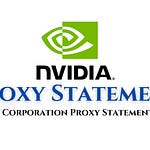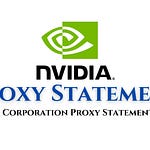NVIDIA's 2022 Annual Review and associated SEC filings highlight a company experiencing significant growth and strategic expansion across diverse, computationally intensive markets. The core of NVIDIA's strategy revolves around its accelerated computing platform, built on a foundation of GPUs, CPUs, networking systems, and extensive software stacks, which are enabling breakthroughs in various industries.
Source: nVidia Proxy Statement for Stockholders Annual Report 2022
Key Themes and Important Ideas:
1. Exceptional Financial Performance in Fiscal Year 2022: NVIDIA had a "record-breaking year" in fiscal year 2022.
Revenue: "$26.91 billion, up 61 percent from $16.68 billion a year ago."
Gross Margins: Expanded to "64.9 percent," an increase of "260 bps" year over year, reflecting "the strength of our business model and execution" despite "industry wide supply chain disruptions and rising costs."
Earnings Per Share (EPS): "$3.85, up 123 percent from a year ago."
Income from Operations: Increased "122% year on year to $10.0 billion."
Record Revenue: Achieved in "Gaming, Data Center, and Professional Visualization" segments, driven by the "incredible ramp of NVIDIA Ampere architecture across our Graphics and Compute and Networking segments."
Shareholder Returns: Returned "$399 million during the year to shareholders through quarterly cash dividends."
2. Strategic Expansion through Accelerated Computing and Platform Approach: NVIDIA's "top priority remains the continued expansion of NVIDIA accelerated computing—creating software, systems, and chips to serve new markets." The company adopts a "platform strategy, bringing together hardware and systems, software, algorithms and libraries, and services."
New Chips: "New chips open new markets." Examples include the "Orin robotics processor chip" for "logistics robots, delivery robots, and self-driving cars, trucks, and taxis," and "Grace," a new "CPU architecture designed for ultra-fast data processing, the essential operation of AI and machine learning." Grace marks NVIDIA's "entry into the CPU market."
New Software: "NVIDIA SDKs, or software development kits, capture the complex computer science and engineering into expertly crafted CUDA libraries." Examples include "cuQuantum SDK" for quantum computing simulation and "cuOpt" for real-time combinatorial complexity planning in logistics. NVIDIA has "more than 450 NVIDIA AI libraries and software development kits."
Integrated Platform: The company emphasizes its "computing stack, or neural network, in four layers: hardware, system software, platform software, and applications. Each layer is open to computer makers, service providers, and developers to integrate with their offerings."
Market Reach: NVIDIA now serves "over three million developers and is available from every major computer maker and cloud, and has been adopted by over 25,000 companies in 100 trillion dollars' worth of industries."
3. Innovation in Graphics (RTX) and its Impact on Digital and Physical Worlds: "Computer graphics is the driving force of NVIDIA."
RTX Technology: NVIDIA RTX "reinvents computer graphics, blurring real and physical worlds." This technology, introduced in 2018, uses "real-time ray tracing and AI image synthesis."
Widespread Adoption: "More than 250 games and apps now use RTX to deliver stunning ray-traced graphics— including AAA blockbusters like Cyberpunk 2077, and digital creation apps like Autodesk 3ds Max, Blender, and the Epic Games' Unreal Engine."
Gaming in the Cloud: The "GeForce NOW cloud gaming service" allows users with "a computer or smartphone" to "rent NVIDIA’s most powerful GPUs and play AAA games like Fortnite and Marvel’s Avengers."
4. Advancements in AI and Robotics, Automating the World: NVIDIA is at the forefront of a "new wave of AI" where "robots perceive the environment, reason about where they are, where they need to go and what they need to do, and then develop a plan to do it."
AI Beyond Perception: While current AI focuses on "perception and pattern recognition," the next phase involves robots with advanced reasoning and planning capabilities.
Diverse Robotic Forms: Robots will take "many forms, physical and digital," including "stock shelves in warehouses or build cars," "medical instruments," and "self-driving cars."
Orin Processor: The "NVIDIA Orin robotics computer powers Isaac, Holoscan, and DRIVE." It is "already powering 25 electric vehicle makers building autonomous vehicles."
Automotive Partnerships: "NVIDIA DRIVE AV computer and software will power Mercedes-Benz's new fleet in 2024. And beginning in 2025, all new Jaguar and Land Rover vehicles will be powered by NVIDIA DRIVE AV."
5. Addressing Grand Challenges: Climate Change and Drug Discovery: NVIDIA's accelerated computing is crucial for tackling "the world's grandest challenges."
Million-X Speedup: "NVIDIA AI computing scaled across a data center can solve scientific challenges a million-x more in speed and scale, opening the door to tackle some of the world's grandest challenges, like drug discovery and climate science."
Earth-2 Digital Twin: NVIDIA is developing "Earth-2 digital twin for regional climate prediction," created in Omniverse, as part of its effort to "battle climate change."
6. Manufacturing Strategy and Supply Chain Management:
Fabless Model: NVIDIA utilizes a "fabless manufacturing strategy," relying on "world-class suppliers for all phases of the manufacturing process." This allows them to "avoid many of the significant costs and risks associated with owning and operating manufacturing operations" and focus resources on "product design, additional quality assurance, marketing, and customer support."
Supply Chain Challenges: The company has faced and continues to face "periods of shortages impacting the semiconductor industry and/or limited supply or capacity." This has led to placing "non-cancellable inventory orders in advance of our historical lead times, and pay premiums and/or provide deposits to secure future supply and capacity." For example, lead times have extended from "approximately six months’ to "at least twelve months."
7. Corporate Governance and Risk Factors:
Strong Corporate Governance: The Board is "committed to strong corporate governance to promote the long-term interests of NVIDIA and our stockholders." They engage with "top institutional holders" on corporate governance, diversity, inclusion, and ESG.
Board Diversity: The Board Diversity Matrix indicates a commitment to diverse representation in terms of gender identity and demographic background.
Risk of Acquisitions: Acquisitions "involve significant challenges and risks." The termination of the Arm acquisition is cited as an example, resulting in a "$1.36 billion charge" due to "significant regulatory challenges."
Intellectual Property (IP) Protection: NVIDIA relies on "patents, trademarks, trade secrets, employee and third-party nondisclosure agreements, and licensing arrangements to protect our IP." However, IP protection varies internationally, and "the laws of certain foreign countries...may not protect our products or IP rights to the same extent as the laws of the United States."
In summary, NVIDIA is a highly profitable and innovative company that is strategically expanding its accelerated computing platforms beyond its gaming roots into critical new markets like AI, robotics, and scientific computing, while also navigating complex global supply chain and regulatory environments. Its focus on integrated hardware and software solutions positions it as a key player in shaping the future of computing.













Share this post